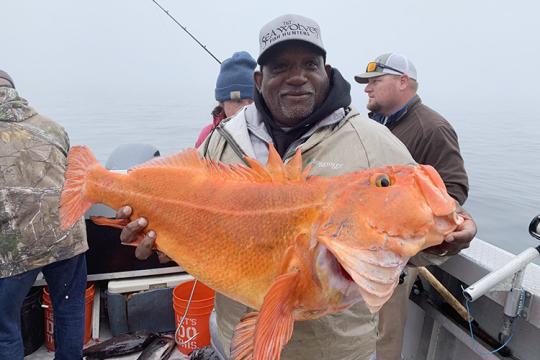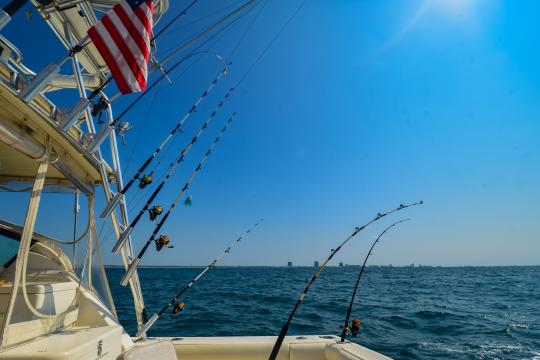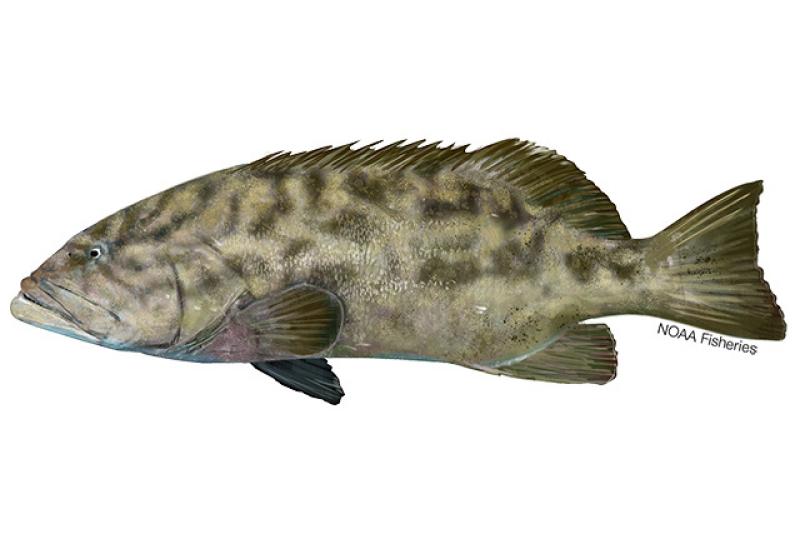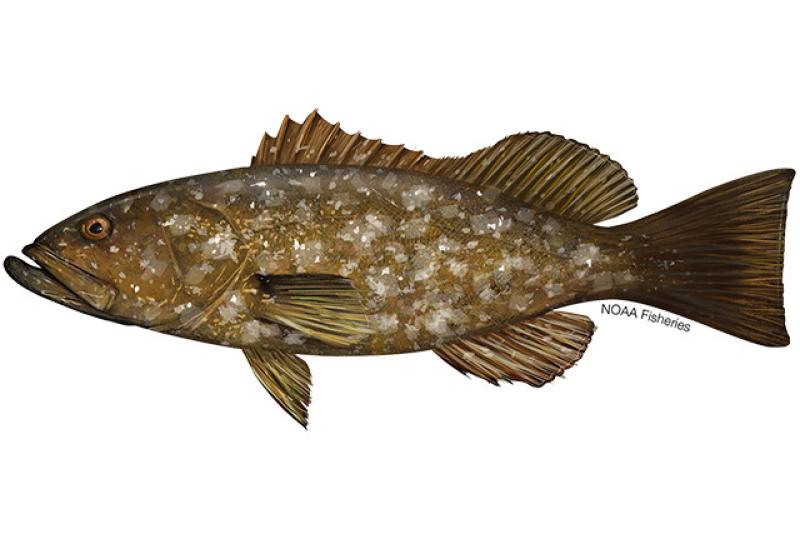 Gag grouper. Credit: NOAA Fisheries
Gag grouper. Credit: NOAA Fisheries
Gag grouper. Credit: NOAA Fisheries
About the Species
 Gag grouper. Credit: NOAA Fisheries
Gag grouper. Credit: NOAA Fisheries
Gag grouper. Credit: NOAA Fisheries
U.S. wild-caught gag grouper is a smart seafood choice because it is sustainably managed and responsibly harvested under U.S. regulations.

Population
The Gulf of America* (formerly Gulf of Mexico) and South Atlantic stocks are overfished. The fishing rate established under rebuilding plans for these stocks promotes population growth.

Fishing Rate
Subject to overfishing.

Habitat Impact
Fishing gear used to harvest gag grouper has minimal impacts on habitat.

Bycatch
Regulations are in place to minimize bycatch.
Population Status
- There are two stocks of gag: South Atlantic and Gulf of America. According to the most recent stock assessments:
- The South Atlantic stock is overfished (2021 stock assessment), and is subject to overfishing based on 2023 catch data. Summary stock assessment information can be found on Stock SMART.
- The Gulf of America stock is overfished and subject to overfishing (2021 stock assessment). Summary stock assessment information can be found on Stock SMART.
Appearance
- Gag have long, compressed bodies.
- Their coloring varies with their size. Large gag are dark brownish-gray above and paler below, with traces of dark wavy markings on the sides. Smaller fish are much lighter and have dark brown or charcoal kiss-like marks along their sides.
- Gag’s scientific species name, microlepis, is derived from the Greek words “micro” for small and “lepis” meaning scale, in reference to the small scales of this fish.
Biology
- Gag grow slowly, can reach more than 3 feet in length, and weigh up to 50 pounds.
- They can live as long as 30 years.
- They are protogynous hermaphrodites—they begin life as females and sexually mature around age 4. As they grow older, they change to males, around age 8.
- They spawn from mid-January to early May in the South Atlantic and from late January to mid-April in the Gulf of America. Gag spawn in large groups along the continental shelf. Females spawn multiple times per season, releasing between 60,000 and 1.7 million eggs each time they spawn.
- They eat a variety of fish, crabs, shrimp, and squid.
- Adult gag and large fish prey on juvenile gag.
- Sharks and other large fish prey on adult gag.
Where They Live
Range
- Gag are found in the western Atlantic, primarily from North Carolina to the Yucatan Peninsula of Mexico, including the Gulf of America (formerly Gulf of Mexico).
Habitat
- Adults live offshore and prefer hard-bottom habitat including reefs and wrecks, and live bottom (sponges, corals and sea squirts), and depressions and ledges.
- Juveniles live in estuaries in structured habitats, including seagrass beds, oyster reefs, and shipwrecks.
Fishery Management
- NOAA Fisheries and the South Atlantic and Gulf Fishery Management Councils manage the gag fishery.
- In the South Atlantic, managed under the Snapper Grouper Fishery Management Plan:
- Annual catch limit allocated between the commercial (51 percent) and recreational (49 percent) fisheries.
- Commercial fishermen must have a limited access permit to fish, land, or sell snapper and grouper species. Managers limit the number of available permits to control the number of fishermen harvesting these species.
- A minimum size limit to prevent harvest of immature gag.
- A number of gear requirements and restrictions help reduce bycatch and protect habitat.
- Both the commercial and recreational fishing seasons are closed from January through April to protect all shallow-water grouper during their spawning season.
- Recreational fishermen have a bag limit and commercial fishermen have a trip limit.
- Eight marine protected areas closed to fishing for and possession of snapper and grouper to protect a portion of the population and habitat of long-lived deep-water species.
- A rebuilding plan to rebuild the stock to the target population level is in place with a target date of 2033.
- In the Gulf of America, managed under the Gulf of America Reef Fish Fishery Management Plan:
- Annual catch limit allocated between the commercial (39 percent) and recreational (61 percent) fisheries.
- An individual fishing quota (IFQ or catch shares) program allocates the commercial quota among shareholders. Fishermen may harvest their individual allocation whenever they choose and must report how much they harvest through a strict reporting program.
- Minimum size limit to protect immature gag.
- Restrictions on the type of gear fishermen may use and where they can fish, to reduce bycatch and protect spawning groups.
- Area closures for both commercial and recreational fisheries to protect spawning groupers.
- Recreational fishermen have a bag limit.
Harvest
- Commercial fishery:
- In 2023, commercial landings of gag totaled 460,000 pounds valued at $3 million, according to the NOAA Fisheries commercial fishing landings database. Most commercial harvest comes from the west coast of Florida.
- Gear types, habitat impacts, and bycatch:
- Commercial fishermen mainly use vertical hook-and-line gear to harvest gag, and some also use longlines and spears.
- Trawl gear, fish traps, and bottom longlines are prohibited in some areas to reduce bycatch. Several areas are closed to all fishing to protect snappers and groupers, including gag.
- Sea turtles and other reef fishes, such as snappers and groupers, can be incidentally caught while fishing for gag.
- In certain areas, fishermen are required to use circle hooks to improve the chance of survival of any unintentionally caught fish and to reduce turtle hookings.
- Commercial and charterboat/headboat reef fish fishermen must use appropriate release gear and follow handling protocols to increase the chance of survival for any incidentally caught sea turtles.
- Fishermen are encouraged to use venting tools or fish descenders when fish are caught showing signs of barotrauma. Barotrauma occurs when reef fish are quickly brought to the surface by hook-and-line and the gas in their swimbladders over expands. Venting tools help deflate the expanded abdominal cavity, preventing serious injury to the fish and making it easier for them to return to deep water.
- Recreational fishery:
- Gag makes up a large part of the recreational harvest in the South Atlantic and Gulf of America. In 2023, recreational harvest totaled 1.5 million pounds, according to the NOAA Fisheries recreational fishing landings database.
- In the South Atlantic:
- Annual catch limits and accountability measures.
- Bag and size limits.
- In the Gulf of America:
- Annual catch limits and accountability measures.
- Bag and size limits.
*Executive Order 14172, “Restoring Names That Honor American Greatness” (Jan. 20, 2025), directs that the Gulf of Mexico be renamed the Gulf of America. Gulf of America references in this website refer to the same area as the Gulf of Mexico in the applicable regulations under 50 CFR parts 216–219, 222–226, and 600–699. The name change did not result in any changes to, and had no effect on the applicability or enforceability of, any existing regulations. This website continues to use “Gulf of Mexico” when quoting statutes, existing regulations, or previously published materials.
Scientific Classification
- Gag are found in the western Atlantic, primarily from North Carolina to the Yucatan Peninsula of Mexico, including the Gulf of America (formerly Gulf of Mexico).
- Adults live offshore and prefer hard-bottom habitat including reefs and wrecks, and live bottom (sponges, corals and sea squirts), and depressions and ledges.
- Juveniles live in estuaries in structured habitats, including seagrass beds, oyster reefs, and shipwrecks.
Fishery Management
- NOAA Fisheries and the South Atlantic and Gulf Fishery Management Councils manage the gag fishery.
- In the South Atlantic, managed under the Snapper Grouper Fishery Management Plan:
- Annual catch limit allocated between the commercial (51 percent) and recreational (49 percent) fisheries.
- Commercial fishermen must have a limited access permit to fish, land, or sell snapper and grouper species. Managers limit the number of available permits to control the number of fishermen harvesting these species.
- A minimum size limit to prevent harvest of immature gag.
- A number of gear requirements and restrictions help reduce bycatch and protect habitat.
- Both the commercial and recreational fishing seasons are closed from January through April to protect all shallow-water grouper during their spawning season.
- Recreational fishermen have a bag limit and commercial fishermen have a trip limit.
- Eight marine protected areas closed to fishing for and possession of snapper and grouper to protect a portion of the population and habitat of long-lived deep-water species.
- A rebuilding plan to rebuild the stock to the target population level is in place with a target date of 2033.
- In the Gulf of America, managed under the Gulf of America Reef Fish Fishery Management Plan:
- Annual catch limit allocated between the commercial (39 percent) and recreational (61 percent) fisheries.
- An individual fishing quota (IFQ or catch shares) program allocates the commercial quota among shareholders. Fishermen may harvest their individual allocation whenever they choose and must report how much they harvest through a strict reporting program.
- Minimum size limit to protect immature gag.
- Restrictions on the type of gear fishermen may use and where they can fish, to reduce bycatch and protect spawning groups.
- Area closures for both commercial and recreational fisheries to protect spawning groupers.
- Recreational fishermen have a bag limit.
Harvest
- Commercial fishery:
- In 2023, commercial landings of gag totaled 460,000 pounds valued at $3 million, according to the NOAA Fisheries commercial fishing landings database. Most commercial harvest comes from the west coast of Florida.
- Gear types, habitat impacts, and bycatch:
- Commercial fishermen mainly use vertical hook-and-line gear to harvest gag, and some also use longlines and spears.
- Trawl gear, fish traps, and bottom longlines are prohibited in some areas to reduce bycatch. Several areas are closed to all fishing to protect snappers and groupers, including gag.
- Sea turtles and other reef fishes, such as snappers and groupers, can be incidentally caught while fishing for gag.
- In certain areas, fishermen are required to use circle hooks to improve the chance of survival of any unintentionally caught fish and to reduce turtle hookings.
- Commercial and charterboat/headboat reef fish fishermen must use appropriate release gear and follow handling protocols to increase the chance of survival for any incidentally caught sea turtles.
- Fishermen are encouraged to use venting tools or fish descenders when fish are caught showing signs of barotrauma. Barotrauma occurs when reef fish are quickly brought to the surface by hook-and-line and the gas in their swimbladders over expands. Venting tools help deflate the expanded abdominal cavity, preventing serious injury to the fish and making it easier for them to return to deep water.
- Recreational fishery:
- Gag makes up a large part of the recreational harvest in the South Atlantic and Gulf of America. In 2023, recreational harvest totaled 1.5 million pounds, according to the NOAA Fisheries recreational fishing landings database.
- In the South Atlantic:
- Annual catch limits and accountability measures.
- Bag and size limits.
- In the Gulf of America:
- Annual catch limits and accountability measures.
- Bag and size limits.
*Executive Order 14172, “Restoring Names That Honor American Greatness” (Jan. 20, 2025), directs that the Gulf of Mexico be renamed the Gulf of America. Gulf of America references in this website refer to the same area as the Gulf of Mexico in the applicable regulations under 50 CFR parts 216–219, 222–226, and 600–699. The name change did not result in any changes to, and had no effect on the applicability or enforceability of, any existing regulations. This website continues to use “Gulf of Mexico” when quoting statutes, existing regulations, or previously published materials.
Scientific Classification
| Kingdom | Animalia | Phylum | Chordata | Class | Actinopterygii | Order | Perciformes | Family | Serranidae | Genus | Mycteroperca | Species | microlepis |
|---|
Last updated by NOAA Fisheries on 04/24/2025
Featured News
 Anglers identify signs of barotrauma on a red snapper. (Credit: Return ‘Em Right)
Anglers identify signs of barotrauma on a red snapper. (Credit: Return ‘Em Right)
Return ‘Em Right: Meet the People Helping Anglers Save Fish One Release at a Time

 Saltwater fishing boat with poles in the Gulf of Mexico near Alabama.
Saltwater fishing boat with poles in the Gulf of Mexico near Alabama.
Shark Depredation: A Frustrating Experience for Fishermen in the Atlantic
 Juvenile coho salmon. Credit: iStock
Juvenile coho salmon. Credit: iStock
NOAA Fisheries Releases 2023 Status of Stocks
Seafood Facts

Is Gag Grouper Sustainable?
U.S. wild-caught gag grouper is a smart seafood choice because it is sustainably managed and responsibly harvested under U.S. regulations.
Availability
Fresh year-round in the Gulf of America (formerly Gulf of Mexico), and from May through December in the South Atlantic.
Source
U.S. wild-caught from North Carolina to Texas.
Taste
Mild but distinct flavor, somewhere between bass and halibut.
Texture
Firm, moist, and flaky.
Color
White when both raw and cooked.
Health Benefits
Grouper is low in saturated fat. It is also a good source of vitamins B6 and B12, phosphorus, potassium, protein, and selenium.
Nutrition Facts
Servings: 1; Serving Weight: 100 g (raw); Calories: 92 ; Protein: 19.38 g; Total Fat: 1.02 g; Total Saturated Fatty Acids: 0.233 g; Carbohydrate: 0 g; Total Sugars: 0 g; Total Dietary Fiber: 0 g; Cholesterol: 37 mg; Selenium: 36.5 mcg; Sodium: 53 mgMore Information
Last updated by NOAA Fisheries on 04/24/2025
Seafood News
 Celebrate Culinary Arts Month with a sustainable seafood recipe for every month of the year.
Celebrate Culinary Arts Month with a sustainable seafood recipe for every month of the year.
What Your Birth Month Says About Your Next Seafood Recipe
 Fresh-caught taʻape on ice. Credit: Conservation International Hawaiʻi.
Fresh-caught taʻape on ice. Credit: Conservation International Hawaiʻi.
Reducing Waste and Feeding Communities in Hawaiʻi with a Whole Fish Approach
 Chef Tyler Hadfield’s Curried Skate Wings with Tomato-Masala Chutney
Chef Tyler Hadfield’s Curried Skate Wings with Tomato-Masala Chutney
Ring In the New Year With These Crowd-Favorite Seafood Recipes
 NOAA Fisheries, in collaboration with Blue Ocean Mariculture, is conducting a multi-year pilot study to evaluate observational methods and tools for studying Hawaiian monk seal behavior. Courtesy of Blue Ocean Mariculture
NOAA Fisheries, in collaboration with Blue Ocean Mariculture, is conducting a multi-year pilot study to evaluate observational methods and tools for studying Hawaiian monk seal behavior. Courtesy of Blue Ocean Mariculture
AI Meets Aquaculture to Study Hawaiian Monk Seal Interactions With Net Pens
Documents
Southeast Otter Trawl and Reef Fish Fisheries Observer Materials
For the Characterization of the U.S. Gulf of Mexico and Southeastern Atlantic Otter Trawl and…
Economics of the Gulf of Mexico Reef Fish Fishery – 2015
ELIZABETH OVERSTREET AND CHRISTOPHER LIESE
Economics of the Gulf of Mexico Reef Fish Fishery – 2016
ELIZABETH OVERSTREET AND CHRISTOPHER LIESE
Data & Maps
Outreach & Education
Approved Models and Equipment for Careful Release of Sea Turtles Caught in Gulf of Mexico Reef Fish Fishery and South Atlantic Snapper Grouper Fishery
Information to help fishermen comply with sea turtle release requirements contained in regulations…
Frequent Questions: Landing Federally-Managed Reef Fish Commercially Harvested from Gulf of Mexico Federal Waters
Last Updated: March 2019
Last updated by NOAA Fisheries on 04/24/2025





